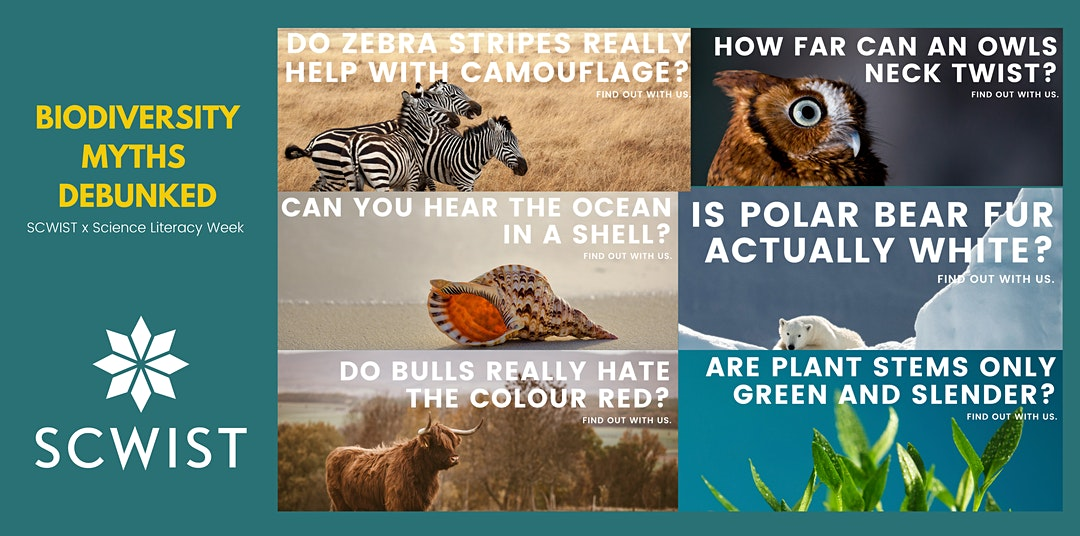Helping Youth Attain Science Literacy
Back to Posts
Helping Youth Attain Science Literacy
By Mandy McDougall (SCWIST Digital Content Creator and Youth Engagement Committee Member)
Have you ever heard a scientific statement or read a headline claiming science and thought to yourself, “Is that really true?”
Enter the concept of science literacy
What exactly is science literacy? Science literacy, also referred to as scientific literacy, describes the ability to think critically about scientific information. A person does not need to be a scientist to have a high level of science literacy. Rather, science literacy is an important skill for anyone who accesses information through reading, watching, or listening — in other words, it’s an important skill for us all.
Science literacy is important for separating fact from fiction, differentiating truth from misinformation, and for questioning statements like the ones above.
The importance of science literacy has become even more apparent given our current global situation (you know, the whole pandemic thing). The spread of misinformation has been rampant, and Canadian scientists are working hard to remind the public of the importance of science literacy as our knowledge and understanding of COVID-19 continues to evolve on an almost daily basis. While in this context, science literacy is important for adults, it is also imperative to introduce the concept to youth to form the foundation of their critical thinking skills.
Debunking Science Myths
SCWIST recently explored the concept of science literacy with our youth community during Canadian Science Literacy Week, held from September 21st to 27th. The theme of this year’s week-long promotion of science literacy was biodiversity. Canada is a vast country with a generous amount of biodiversity in its many climates, ecosystems, and species.
During Canadian Science Literacy Week, SCWIST virtually joined classrooms across BC to debunk popular science myths about biodiversity. Participants were asked: Have you ever heard that zebra stripes exist only for camouflage? How about being able to hear the ocean in a conch shell? Have you ever wondered whether bulls are actually aggravated by the colour red?
It was revealed that all of those statements are actually popular myths in biodiversity. These and other questions (Is polar bear fur actually white? Can owls turn their heads all the way around?) were explored and ultimately answered through the application of science literacy.
Vaishnavi Sridhar, Youth Engagement Project Coordinator with SCWIST, organized the workshops. “We all remember things we heard as we were growing up, assuming they were true,” she said in an interview with CBC Radio. “Many things we think are actually misconceptions”.
The workshops were designed to teach participants, aged 8-15 (plus adults, too!) about one biodiversity myth each day, using at-home experiments that participants could easily put together themselves.
Here is another example of a myth that was evaluated: Do bulls hate the colour red? Well, bulls are in fact colour blind; they cannot actually see red. To bulls, the cape appears a yellow-grey colour. So what is the reason behind the myth?
In this workshop, participants learned about eyesight and colour blindness using vision simulator apps.
A chromatic vision simulator was used to simulate the movement of a moving cloth and other common objects, such as apples and oranges to someone with red-green colour blindness. The lesson? No matter what colour cloth you wave in front of a bull, it is just as likely to charge. It is the continuous waving of the cloth that aggravates bulls. (You can try this yourself using colour-blindness simulators such as Coblis or Chromatic Vision Simulator).
Through hands-on activities, participants became scientists, learning about the explanations for natural phenomena around us. They learned that it is possible to conduct simple experiments at school or at home to better understand the world around us.
While these activities were fun and engaging, you may be wondering what the value is in debunking myths and challenging common perspectives. These activities enable us to “understand how the world works around us and to know to take observations and make detailed notes,” says Vaishnavi.
A person who has learned the skills described by Vaishnavi can assess the quality of scientific information and determine whether the source, statements, and implications are based on ‘good’ science, as a result of becoming scientifically literate.
Stay Connected
- Be sure to check out the CBC Radio interview “Why do zebras have stripes?: Science Literacy Week events aim to debunk myths” featuring Vaishnavi Sridhar.
- Stay up to date with all the latest SCWIST news and events by connecting with us on LinkedIn, Facebook, Instagram and X, or by subscribing to our newsletter.
Thank You
SCWIST’s Science Literacy Week activities were made possible by NSERC’s PromoScience Supplemental Grant for Science Literacy Week 2020. Special thanks to Vaishnavi Sridhar for her efforts in organizing a week-long series of informative talks and experiments to promote science literacy among Canadian youth. Learn more about SCWIST’s ms infinity programming for youth.
Mandy McDougall is a Digital Content Creator and Youth Engagement Committee Member for SCWIST. Outside of SCWIST, she is an Environmental Scientist in Vancouver, Canada.